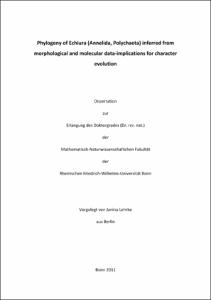Lehrke, Janina: Phylogeny of Echiura (Annelida, Polychaeta) inferred from morphological and molecular data-implications for character evolution. - Bonn, 2012. - Dissertation, Rheinische Friedrich-Wilhelms-Universität Bonn.
Online-Ausgabe in bonndoc: https://nbn-resolving.org/urn:nbn:de:hbz:5n-29716
Online-Ausgabe in bonndoc: https://nbn-resolving.org/urn:nbn:de:hbz:5n-29716
@phdthesis{handle:20.500.11811/5379,
urn: https://nbn-resolving.org/urn:nbn:de:hbz:5n-29716,
author = {{Janina Lehrke}},
title = {Phylogeny of Echiura (Annelida, Polychaeta) inferred from morphological and molecular data-implications for character evolution},
school = {Rheinische Friedrich-Wilhelms-Universität Bonn},
year = 2012,
month = sep,
note = {Contrary to echiuran monophyly, which is unambiguously supported by several autapomorphies, echiuran phylogenetic intra-relationships are still unknown to date. In order to contribute to a clarification this thesis investigates the phylogenetic relationships of all high-ranking subgroups using morphological and molecular phylogenetic analyses. In order to enlarge the morphological dataset, two traditional diagnostic character complexes were studied comparatively on the basis of light and scanning electron microscopy as well as histological investigations (anal sacs: seven species, gonostomal lips: five species). For one species (Thalassema thalassemum, Thalassematidae) the ultrastructure of the anal sacs including their funnels was studied. In addition, the ultrastructure of spermatozoa was investigated in two species, each assigned to one subgroup. The ultrastructure of the larval protonephridia was made accessible for T. thalassemum. After a critical evaluation of the relevant states, potentially phylogenetic informative characters were compiled within a data matrix. The data matrix was complemented by literature data for missing representatives of all subgroups and additional diagnostic characters from literature. In total, a cladistic analysis was conducted using 47 morphological characters. A molecular phylogeny (18S rDNA + 16S rRNA + MT-CO1) was established on the basis of 16 new gene sequences together with already published data from Genbank. Regardless of the method used, all analyses recover a resolution that opposes to the traditional classification and to previous phylogenetic hypotheses. Favoured morphological and molecular tree are congruent in identifying two major clades, hitherto referred to as Bonellia-group and Urechis-group, as well as a basal resolution of some traditional thalassematid taxa (i.e., Arhynchite pugettensis). The Bonellia-group includes monophyletic traditional Ikedaidae within paraphyletic traditional Bonelliidae. Monophyly of the Bonellia-group is well supported by the molecular tree. The Urechis-group is highly supported by both analyses and incorporates traditional Echiuridae + Urechidae. Traditional Urechidae are recovered as a clade. Due to the molecular tree a sister group relationship of Bonellia- and Urechis-group is well supported. The favoured morphological tree in contrast supports a sister group relationship of Bonellia-group and the remaining echiurans (Arhynchite pugettensis excluded). However, thus far no morphological characters are known that could sustain any of the two sister group hypotheses. The main difference between morphological and molecular tree concern the resolution of “Thalassematidae”: they either form a paraphyletic assemblage to the remaining echiurans (favoured by molecular sequences), or they are polyphyletic, with Arhynchite pugettensis as basalmost offshoot within Echiura (favoured by morphology). In the latter case the remaining thalassematids are resolved as paraphyletic assemblage with respect to the Urechis-group. Subsequently, a final conclusion is not possible so far, because neither the analyzed sequence data, nor the enlarged morphological dataset provide an apomorphy for “Thalassematidae”.},
url = {https://hdl.handle.net/20.500.11811/5379}
}
urn: https://nbn-resolving.org/urn:nbn:de:hbz:5n-29716,
author = {{Janina Lehrke}},
title = {Phylogeny of Echiura (Annelida, Polychaeta) inferred from morphological and molecular data-implications for character evolution},
school = {Rheinische Friedrich-Wilhelms-Universität Bonn},
year = 2012,
month = sep,
note = {Contrary to echiuran monophyly, which is unambiguously supported by several autapomorphies, echiuran phylogenetic intra-relationships are still unknown to date. In order to contribute to a clarification this thesis investigates the phylogenetic relationships of all high-ranking subgroups using morphological and molecular phylogenetic analyses. In order to enlarge the morphological dataset, two traditional diagnostic character complexes were studied comparatively on the basis of light and scanning electron microscopy as well as histological investigations (anal sacs: seven species, gonostomal lips: five species). For one species (Thalassema thalassemum, Thalassematidae) the ultrastructure of the anal sacs including their funnels was studied. In addition, the ultrastructure of spermatozoa was investigated in two species, each assigned to one subgroup. The ultrastructure of the larval protonephridia was made accessible for T. thalassemum. After a critical evaluation of the relevant states, potentially phylogenetic informative characters were compiled within a data matrix. The data matrix was complemented by literature data for missing representatives of all subgroups and additional diagnostic characters from literature. In total, a cladistic analysis was conducted using 47 morphological characters. A molecular phylogeny (18S rDNA + 16S rRNA + MT-CO1) was established on the basis of 16 new gene sequences together with already published data from Genbank. Regardless of the method used, all analyses recover a resolution that opposes to the traditional classification and to previous phylogenetic hypotheses. Favoured morphological and molecular tree are congruent in identifying two major clades, hitherto referred to as Bonellia-group and Urechis-group, as well as a basal resolution of some traditional thalassematid taxa (i.e., Arhynchite pugettensis). The Bonellia-group includes monophyletic traditional Ikedaidae within paraphyletic traditional Bonelliidae. Monophyly of the Bonellia-group is well supported by the molecular tree. The Urechis-group is highly supported by both analyses and incorporates traditional Echiuridae + Urechidae. Traditional Urechidae are recovered as a clade. Due to the molecular tree a sister group relationship of Bonellia- and Urechis-group is well supported. The favoured morphological tree in contrast supports a sister group relationship of Bonellia-group and the remaining echiurans (Arhynchite pugettensis excluded). However, thus far no morphological characters are known that could sustain any of the two sister group hypotheses. The main difference between morphological and molecular tree concern the resolution of “Thalassematidae”: they either form a paraphyletic assemblage to the remaining echiurans (favoured by molecular sequences), or they are polyphyletic, with Arhynchite pugettensis as basalmost offshoot within Echiura (favoured by morphology). In the latter case the remaining thalassematids are resolved as paraphyletic assemblage with respect to the Urechis-group. Subsequently, a final conclusion is not possible so far, because neither the analyzed sequence data, nor the enlarged morphological dataset provide an apomorphy for “Thalassematidae”.},
url = {https://hdl.handle.net/20.500.11811/5379}
}






